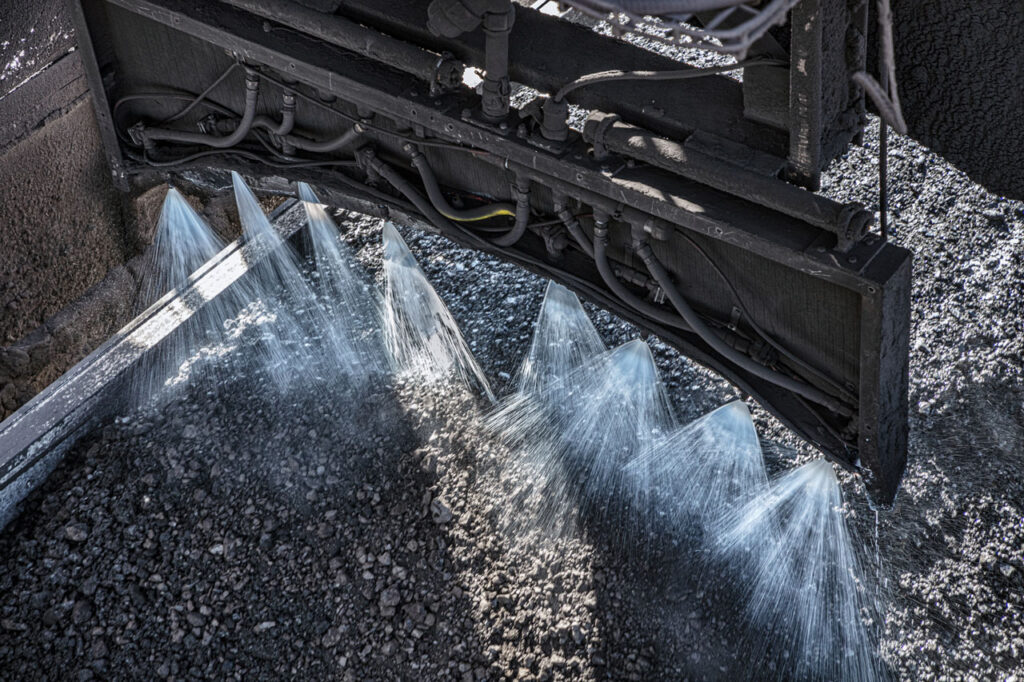Our Approach to Air
Our subsidiary operations actively work to reduce impacts on air quality. Particulate matter, wind speed, and weather conditions are monitored continuously, and planning and execution of certain activities are adjusted to limit the generation of dust.
Air emissions associated with mining and preparation processes can include dust, emissions from combustion of fuels including vehicle exhaust, and releases of naturally occurring gases from the geologic strata during the mining process.
Potential dust sources include vehicle traffic on unpaved mine roads, dumping and loading activities, material crushing, conveying, storage, and — at certain sites — blasting.


Arch’s subsidiary operations use an array of methods and tools to protect air quality, including water sprays, enclosures and dust suppressants.
A variety of methods are used to prevent or limit the generation of fugitive and non-fugitive dust emissions. The primary means is to limit those activities that create the potential for generating airborne dust. These may include strategically positioning equipment and routing vehicle traffic patterns for shortened haul ways as well as surfacing long-term roads with stone.
While operations are underway, specific engineering controls are designed into the process equipment to help reduce the generation of airborne particulates. Examples of these engineering controls include enclosures on coal and refuse conveyance devices, water sprays at material transfer points, the application of dust suppressants on road surfaces and coal storage piles, and the use of baghouse filter systems to capture particulates during transfers of bulk loads of fine-grained process materials, to mention only a few.
While operations are underway, specific engineering controls are designed into the process equipment to help reduce the generation of airborne particulates.
During high-wind events, excess coal dust can become airborne. To prevent the release of particulates, and to preserve valuable product, the West Elk mine in Colorado developed methods to apply a non-hazardous surface crusting agent to coal piles, using a combination of truck-mounted water cannons and a dozer-mounted applicator in order to solidify the surface of the pile. These crusting agents are applied in lieu of traditional water applications, which tend to have limited utility once the water evaporates. The crusting agents remain in place for as long as the pile remains undisturbed.
In December 2023, the State of Colorado issued a Title V Operating Permit to the West Elk Mine establishing limits on volatile organic compound (VOC) emissions from mine ventilation air. This was the first permit of its kind in the United States. The permit establishes a site-wide VOC limit and relies on emissions data gathered in accordance with a detailed sampling plan approved by the state. As part of this process, the West Elk mine, in conjunction with the State of Colorado, pioneered the methodology for collecting VOC data within the mine. The draft permit went through extensive public comment and a public hearing. Two environmental groups petitioned EPA to review the permit. In a ruling issued on May 24, 2024, EPA requested that the State of Colorado clarify certain definitions and review and amend, if necessary, certain monitoring requirements. The West Elk mine continues to comply with the permit as issued.
Criteria Emissions
Arch’s subsidiary operations deemed to have the potential to exceed certain emissions thresholds for designated “criteria pollutants” — including particulate matter, carbon monoxide, sulfur oxides and nitrogen oxides — operate under air program permits issued by their respective states. In instances when these permits establish limits on emissions of these pollutants, Arch’s subsidiary operations are required to report their actual emissions to the state air regulators on a permit-specified interval — typically annually.
Emissions of Four Criteria Pollutants
(for Arch and its operating subsidiaries, in tons)
| Particulate Matter | 2019 | 2020 | 2021 | 2022 | 2023 |
|---|---|---|---|---|---|
| Corporate Total | 4,774 | 4,250 | 4,244 | 4,393 | 5,348 |
| Carbon Monoxide | 2019 | 2020 | 2021 | 2022 | 2023 |
|---|---|---|---|---|---|
| Corporate Total | 12,811 | 10,643 | 10,658 | 11,618 | 11,583 |
| Sulfur Oxides | 2019 | 2020 | 2021 | 2022 | 2023 |
|---|---|---|---|---|---|
| Corporate Total | 118 | 102 | 102 | 125 | 114 |
| Nitrogen Oxides | 2019 | 2020 | 2021 | 2022 | 2023 |
|---|---|---|---|---|---|
| Corporate Total | 11,337 | 9,145 | 9,268 | 10,294 | 10,676 |
Arch is targeting ongoing reductions in these criteria pollutants as it continues its strategic transition, including the systematic reduction in its thermal operating footprint.